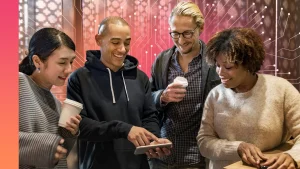Is your sermon struggling to hold the congregation’s attention? Stories might be the key you’re missing. In today’s fast-paced world, where distractions are just a scroll away, storytelling has become an essential tool for effective communication. In sermons, it can transform your message from a routine lecture into an engaging and memorable experience. Why? Because stories resonate. They connect emotionally, spark curiosity, and invite listeners into a shared journey of faith and understanding. By weaving authentic narratives into your sermons, you can speak directly to the hearts of your audience, making your message not just heard, but felt. Get ready to explore how this timeless art can breathe life into your speech and elevate your connection with your congregation.
Understanding the Power of Story in Sermons
Stories are more than just words strung together. They are bridges connecting the speaker to the heart of every listener in the pews. A well-told story can touch souls and illuminate spiritual paths in ways mere facts often cannot. They help us see things from new perspectives, allowing us to grasp complex ideas with clarity and insight.
The Psychological Impact of Storytelling
When you integrate storytelling into sermons, you unlock a potent psychological tool. Stories trigger emotional responses that other forms of communication struggle to evoke. Consider how a gripping plot or a relatable character can draw you in effortlessly. This happens because stories open emotional doors in our minds, making us feel involved and present.
Stories also play a crucial role in memory retention. It’s no secret that our brains are wired to remember stories better than plain data. Imagine your brain as a filing cabinet — narratives categorize and file away information in a way that’s easier to retrieve. That’s the magic of storytelling: it makes sermons memorable and impactful.
Stories as a Teaching Tool
The true beauty of stories lies in their ability to simplify the complex. Think of them as a lens, sharpening our focus on the abstract and sometimes puzzling truths of life. Stories transform these complexities into something understandable and relatable.
For instance, parables and anecdotes often carry deep spiritual lessons in an easily digestible format. They speak to us in our own language, using everyday experiences to mirror profound truths. This accessibility helps convey messages that might otherwise seem distant or daunting.
Moreover, stories have an incredible way of breaking down barriers. They create a common ground, a shared space where listeners can engage with the sermon on a personal level. This connection fosters understanding and encourages reflection, inviting the congregation to explore their faith with open hearts. So next time you stand at the pulpit, think of a story as your sermon’s lighthouse, guiding your audience through the murky waters of abstract concepts to the shores of clarity and revelation.
Elements of Compelling Sermon Stories
Crafting stories that captivate an audience hinges on a few key elements. To make sermon stories impactful, they must connect deeply with the listener. This connection often depends on the relatability of the characters, the presence of a compelling conflict and resolution, and the grounding effect of a clear setting. Let’s dive into each element to see how they contribute to meaningful storytelling.
Relatable Characters
Characters are the heartbeats of any story. They provide a human touch that sermons need to resonate with congregations deeply. Why is that crucial? Because listeners find themselves in these characters. They see their struggles, triumphs, and faith reflected back at them.
A relatable character doesn’t need to be perfect. In fact, imperfections often make them more engaging. Think about the characters in parables. They’re typically ordinary people facing life’s typical challenges. These figures speak to us because they mirror our own experiences, fostering empathy and understanding. When creating characters, ask yourself: Can my audience see a part of themselves here?
Conflict and Resolution
Conflict is the engine of any good story. It’s the struggle that moves the narrative forward and keeps the audience engaged. In many ways, conflict in stories mirrors the conflicts we experience in life, from personal dilemmas to struggles with faith.
When crafting sermon stories, it’s important to present conflicts that are relatable and authentic. Whether it’s a moral quandary or a challenge of belief, the conflict should drive the listener to reflect on their own life. The resolution, then, provides closure and insight. It offers a path to understanding and highlights spiritual truths that the audience can carry with them. Remember, a story without conflict is like a sermon without a message—it falls flat.
Setting and Context
A well-defined setting grounds your story, providing a backdrop against which characters and conflicts unfold. Think of the setting as the canvas for your narrative. It adds depth and context, helping the audience visualize and emotionally connect with the story.
In sermons, the setting can be as diverse as a biblical landscape or a modern urban scene. What’s crucial is that it feels real and relatable. The setting should enhance the message, adding layers of meaning and aiding in the congregation’s understanding of the story’s truths. Ask yourself: Does the setting enrich the narrative? Does it help convey the spiritual lessons at hand?
By focusing on these critical elements—relatable characters, conflict and resolution, and a strong setting—you ensure your sermon stories are not just told, but felt and remembered.
Crafting Your Sermon Narrative
Creating a sermon narrative is like crafting a quilt, stitching together threads of wisdom, storytelling, and spiritual insight. This process helps bring clarity to your sermon and tethers your audience to the central message. Let’s explore the nuances of each vital component.
Identifying the Central Message
Every sermon story revolves around a central message. Think of it as the compass that guides the narrative, ensuring that each element of your story points toward this core truth.
Clarify Your Objective: Begin by asking yourself, “What do I want my congregation to understand or feel by the end of my sermon?” This question helps distill complex ideas into a single, resonant thought.
Simplify Your Message: Aim to summarize your central message in a single, clear sentence. If you can’t, it might be worth re-evaluating for clarity. Remember, simplicity fosters understanding.
Focus on Relevance: Ensure the message addresses current issues or struggles within the congregation. A message that resonates with your audience’s experiences has a lasting impact.
Building an Outline for Your Story
A compelling narrative needs a structured outline to guide it seamlessly from start to finish, ensuring it grips your audience’s attention.
The Beginning: Start with a hook — a thought-provoking question, a surprising fact, or a relatable scenario. This intro sets the stage, enticing your audience’s curiosity.
The Middle: This is where the meat of your message lies. Develop your characters, introduce conflict, and unfold the journey, leading your listeners through spiritual exploration. Be sure to maintain a steady pace, preventing any lulls.
The End: Bring the narrative to a satisfying resolution that reinforces your central message. Offer insight or a call to action, leaving your audience inspired to reflect or act.
Incorporating Scriptural References
Scripture is the binding thread that weaves divine truth into your narrative. Integrating it thoughtfully enriches your sermon and grounds your message in faith.
Align with Your Message: Choose passages that support and illuminate your central message. Select scriptures that feel like they were written with your narrative in mind.
Embed Naturally: Seamlessly integrate scripture into your sermon by embedding it into the narrative. It should feel natural, much like spices enhancing a dish, not overtaking it.
Reflect and Relate: After quoting scripture, take time to explain its significance and how it relates to the listeners’ lives. Encourage reflection on how these timeless words offer guidance in contemporary contexts.
Crafting a sermon narrative is an art that combines storytelling finesse with spiritual clarity. By identifying a central message, structuring your story, and weaving in scripture, you create a tapestry that captures hearts and minds, leaving a lasting imprint.
Engaging Your Audience Through Storytelling
To truly captivate your audience during a sermon, you must bring your stories to life. Storytelling in sermons isn’t just about relaying events; it’s about creating an experience that touches hearts and stirs minds. By focusing on how you deliver your message and making it interactive, you can turn passive listeners into active participants. Here’s how to do just that.
Using Vocal Variety and Body Language
The way you deliver a story can make all the difference. Vocal variety is your toolbox; it includes changes in pitch, pace, volume, and tone. Imagine your voice as an artist’s brush, painting the emotions and energy of the narrative. A soft whisper can draw listeners in, while an energetic delivery captures their excitement. Use pauses wisely to build anticipation or give weight to profound moments.
Body language is equally powerful. It’s not just about the words you say, but also how you say them. Gestures can emphasize key points, while facial expressions convey emotions beyond words. Picture yourself as an actor on a stage, using movement to enhance the story. Maintain eye contact to create an intimate connection, making each member of the congregation feel personally engaged.
Interactive Storytelling Techniques
Incorporating your audience into the storytelling process strengthens their connection to your message. Interactive techniques invite participation, prompting the congregation to be more than mere spectators. Here are some approaches to consider:
Ask Questions: Pose open-ended questions throughout your sermon to engage listeners’ thoughts and invite reflection. “What would you do in this situation?” Such prompts not only stir personal reflection but also encourage internal dialogue.
Invite Audience Feedback: Encourage members to share brief thoughts or experiences related to your story. This can be done through short responses or a show of hands. It fosters a sense of community and shared learning.
Role Play: Involve volunteers in a brief role play to demonstrate a point. This hands-on approach keeps things dynamic and memorable, adding a layer of relatability.
Use Technology: Leverage multimedia presentations or interactive polls to involve the tech-savvy segments of your audience. These tools can add depth and engage those who may be visual or interactive learners.
By effectively using these techniques, you not only enhance engagement but also ensure your message resonates long after the sermon ends. Think of your audience as co-creators of the narrative, where each story becomes a shared experience.
Common Pitfalls in Sermon Storytelling
Sermon storytelling can be a powerful way to deliver a message that resonates. Yet, if not done carefully, it can falter. Here are some common pitfalls that can undermine the effectiveness of your sermon stories.
Overly Complex Narratives
Imagine trying to follow a tangled web without a map—you’d get lost, right? In sermon storytelling, complex narratives can have the same effect on your audience. When stories are too intricate or convoluted, listeners struggle to keep up, and the intended message gets muddled.
Why does this happen? Sometimes, in an effort to impress or include every detail, clarity gets sacrificed. Think of your story as a straight path, not a maze. Keep it simple and straightforward. Break down your narrative into clear, digestible parts, and focus on the core message.
Tips to avoid complexity:
Focus on a Single Theme: Stick to one clear message. Too many elements can distract from the main point.
Use Plain Language: Avoid jargon and complicated phrasing. Your audience needs to grasp your story easily.
Limit Characters: Introduce fewer characters to prevent confusion. Too many faces in the story can dilute its impact.
By keeping your narratives straightforward, your message will shine through, ensuring your audience leaves with clarity and inspiration.
Neglecting the Audience’s Context
Just as planting seeds in the wrong soil yields no fruit, ignoring your audience’s context can hinder your sermon’s impact. To truly connect, it’s vital to understand the background and culture of those you’re speaking to.
Why is context important? Each audience brings a unique set of experiences and perspectives. If your sermon doesn’t resonate with their realities, it might fail to engage. Tailoring your stories to their cultural and personal contexts makes them relatable and impactful.
Strategies for understanding context:
Research: Learn about your audience’s cultural, social, and economical backgrounds. Understanding their day-to-day experiences helps shape relevant messages.
Engage in Dialogue: Conversations with members of your congregation can provide insights into their needs and challenges. Use this information to craft stories that speak to their hearts.
Be Culturally Sensitive: Avoid stereotypes or assumptions. Respect and acknowledge diverse perspectives, making everyone feel seen and valued.
Remember, knowing your audience is key. Tailoring your sermon stories to resonate with their context creates a bridge of understanding, making your message more powerful and transformative.
The Importance of Practice and Feedback
Creating sermon stories that captivate your audience takes more than just talent—it’s about honing your craft and embracing feedback. Storytelling is an art that can be shaped and refined through practice, leading to messages that not only inform but deeply resonate with listeners.
Rehearsing Your Delivery
Practice is the cornerstone of effective storytelling. A well-rehearsed delivery ensures your message lands with clarity and impact. Here are some tips for polishing your storytelling technique:
Record Yourself: Use your phone to record a practice session. Listening back, you’ll catch things you might miss in the moment, such as unclear pacing or lackluster parts.
Use a Mirror: Practice in front of a mirror to observe your body language. Notice any distracting habits or gestures and adjust them to enhance, not detract from, your story.
Time Yourself: Keep an eye on the clock. You want to make sure your sermon fits within the time constraints, avoiding rushed parts or prolonged elements.
Focus on Clarity: Enunciate each word clearly to ensure understanding. Practice speaking with varied tones and volumes to maintain the congregation’s engagement throughout.
Try Different Techniques: Experiment with different storytelling techniques like suspense or humor to see what feels natural and effective for your delivery style.
With consistent practice, your stories will become smoother, more engaging, and better at capturing and keeping your audience’s attention.
Seeking Constructive Feedback
Feedback isn’t just about criticism; it’s a tool for growth and improvement. Sharing your stories with peers can provide valuable insights and help elevate your delivery:
Form a Storytelling Group: Assemble a group of trusted colleagues or friends who can provide honest feedback. Regular meetings can foster a supportive environment for creative exchange.
Ask Specific Questions: Request feedback on particular aspects, such as pacing or emotional impact. This will help focus the critique on areas you wish to improve.
Embrace Diverse Perspectives: Encourage feedback from individuals of varied backgrounds and experiences. Different perspectives can reveal blind spots in your story or highlight strengths you hadn’t considered.
Be Open and Reflective: Approach feedback with an open mind. Avoid being defensive and use the comments to reflect on your delivery.
Iterate and Revise: Use the feedback to tweak your stories. Experiment with integrating suggestions and observe how they impact your delivery during rehearsals.
By embracing constructive feedback, you will not only improve your storytelling but also build stories that genuinely resonate with your congregation, fostering a deeper connection and understanding.
Conclusion
Mastering sermon storytelling isn’t just about entertainment; it’s about creating powerful messages that feel personal and impactful. Think of your stories as keys that unlock deeper understanding and engagement. By using relatable characters and real conflicts, you invite your audience into a shared journey of faith.
Engage with your congregation through vocal expression and bhttody language. Use questions to involve them and drive your message home. As you craft your next sermon, remember: it’s not just what you say, but how you say it that makes the difference.
Grab a story, hone your delivery, and watch your message resonate. Ready to try it out this Sunday? Share your thoughts or experiences in the comments—let’s grow together! Want to turn your well-thought-out sermon into unlimited impact try sermon shots and see how it can 10x your sermon impact. Sign up for a 14-day free trial and see what kind of difference it can make for you.





